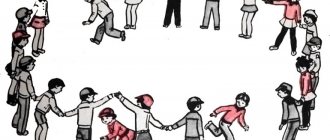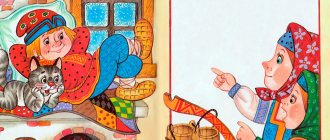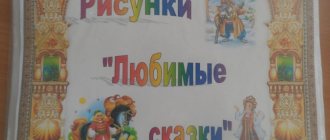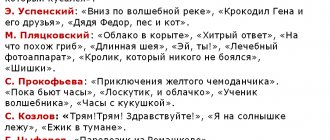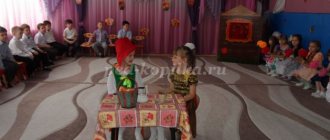The story of the cat and the mouse
In house number five on Kosmonavtov Street, on the third floor in apartment one hundred and twenty-four, there lived a cat named Belka.
Her owners loved her very much, spoiled her in every possible way, and bought her new toys. But the little girl Tanya loved Belka most of all. She even took the cat with her to bed at night. It used to be that Tanya would have a terrible dream, she would get up, grab Belka with both arms and pull her with her. And the cat is only happy about it.
But one day Tanya and her mother went to the pet store and brought home... a mouse. Small, white, in a cage with a wheel. When Squirrel saw that mouse, she almost fainted.
Where have you seen mice live in complete contentment in a house? They are supposed to be caught with mousetraps or cats.
And this mouse also turned out to be impudent. When everyone in the house falls asleep, the lights are turned off, Belka also falls asleep, the mouse slowly gets out of the cage and begins to roam around the rooms, putting things in order. One day Belka caught her in the kitchen in front of a bag of semolina. I tried to chase her, but didn’t have time. The mouse climbed onto the wall, along the wall to the ceiling, and along the ceiling back into Tanya’s bedroom and into his cage. She closed the door and sat there, not moving. It seems like she wasn’t acting out at all.
In fairness
Then Squirrel decided to catch this mouse and eat it. No mouse, no problem. She waited until the night was dark and moonless and pretended to be asleep. The mouse only stuck its sharp nose into the kitchen, only got close to the bag of cereal, and then Squirrel grabbed it.
She held it between her paws and was about to swallow it. She has already revealed her sharp teeth. And as soon as I looked at this tiny animal, all my appetite instantly disappeared. Belka felt sorry for her mistress. How will she grieve for the mouse, poor thing? And she released the rodent. So, either the mouse realized its mistake, or it was scared to death, but since then it hasn’t pulled any more tricks. She sat quietly in the cage and didn’t do anything around the house.
The image of a cat (cat) in Russian folk tales
The cat is a storyteller, he is also a desired treasure
The most striking fairy-tale image of a cat in a Russian fairy tale is Cat Bayun
from the fairy tale
“Go there I don’t know where.”
Here he
is the object of the search, a kind of miracle and at the same time an impossible (almost) task given to the main character
. By the way, Bayun (from the word “bayat”, that is, “to tell”) in different versions of this fairy tale is either the cat’s personal name, or is written with a hyphen with a small letter, that is, it simply indicates his gift as a storyteller.
In general, this is one of the most unusual tales of Russian folklore.
, which seems to exist on its own or comes from a slightly different source than most of the stories we are accustomed to from childhood.
To begin with, the main character here is in different versions - Andrei the Sagittarius , Fedot the Sagittarius, soldier Tarabanov or a merchant's son nicknamed Bezdolny, but never (!) Ivan the Fool or Tsarevich
. Most often he is a royal hunter, supplying game to the sovereign's table. Another “unusuality” is that the hero gets his beautiful wife not at the end of the story, as some kind of reward, but at the very beginning - for no reason at all, then the plot is built around the fact that Sagittarius has to carry out more and more difficult tasks for the king, who simply wants to drive him away from the world in order to marry Princess Marya himself.The tasks vary in different versions of the fairy tale (for example, go find out how the king’s dead father lives in the next world, get golden horns for a deer, golden horns for a goat, a magic mare...
), .
Usually there are three of them and the most important and difficult is the last one - “I don’t know what.”
In fact, the situation becomes even stranger when it turns out that this “I don’t know what” is
an invisible helper or force... named “matchmaker Naum”
!
In other versions it is "Shmat-razum" , "Saura" or simply Nobody.
None of these names appear in other Russian fairy tales.
Andrey the Sagittarius
and the cat Bayun.
Illustration for the fairy tale “Go there - I don’t know where.” In the version recorded by Alexei Tolstoy, one of the royal tasks is precisely the extraction of the bajun cat. The danger of this enterprise lies in the fact that the cat can charm anyone with its fairy tales and send them into an uninterrupted
slumber .
It is noteworthy that
he sits on a high iron pillar, far away in the distant kingdom.
To catch the cat, the shooter, on the advice of his wife, takes with him
three iron caps, three rods and pincers
- the caps protect the hero from the cat's claws, and with the pincers he pulls him off the post.
Soon the fairy tale is told, but not soon the deed is done -
Andrei the shooter to the thirtieth kingdom. Three miles away, sleep began to overcome him. Andrei puts three iron caps on his head, throws his arm over his arm, drags his legs over his legs - he walks, and then rolls around like a roller. Somehow I managed to doze off and found myself at a high pillar.
The cat Bayun saw Andrei, grumbled, purred, and jumped from the post on his head - he broke one cap and broke another, and was about to grab a third.
Then Andrei the shooter grabbed the cat with pincers, dragged him to the ground and started stroking him with the rods...
It is interesting that although at first the cat fights with the hero tooth and nail, but, recognizing himself defeated, he completely loses his hostility and, of his own free will, follows the shooter to where he is leading him.
G.S. Zubkovsky. Cat Bayun on a pole. 1951 “Go there, I don’t know where, bring something, I don’t know what.”
In one of the versions of the tale as recorded by Afanasiev
(No. 215 from volume 2), and in total he has four of them -
ot -bayun is the last building, that is, even more complex than “I don’t know what”
, it is with its capture and taming that the fairy tale ends.
Moreover, the cat here is not a passive object, but an active character
who ultimately helps the archer defeat his enemy - the royal governor.
They walked and and
walked and walked and got where they needed to be; come to the palace, the king saw the cat-bayun and orders: “Come on, cat-bayun ! Show me more passion." The cat sharpens his claws, he gets along with the king; wants to tear his white chest apart, take his living heart out. The Tsar was frightened and began to beg Bezdolny: “Please calm down the bajun cat ! I’ll do anything for you.” - “Bury the governor alive in the ground, now I’ll eat a lot.” The king agreed; They immediately grabbed the governor by the arm and leg, dragged him into the yard and buried him alive in the cheese. And Bezdolny remained to live under the king; the cat-bayun obeyed them both, no one waited on them, and they lived long and cheerfully. That's the whole fairy tale, you can't say more.
The author of the painting is unknown.
The image of the scientist cat Alexander Sergeevich Pushkin, apparently, goes back precisely to such fairy tales about the magical story teller of the cat Bayun.
There is a green oak near the Lukomorye;
Golden chain on the oak tree:
Day and night the cat is a scientist
Everything goes around and around in a chain
;
He goes to the right - the song starts,
To the left - he tells a fairy tale...
Cat - navigator
In some Russian fairy tales, a cat makes a cameo appearance when
one of the characters (a young girl/woman, Ivan) gets lost in the forest.
Here the cat acts as a savior, showing the way out of the thicket . He is initially friendly towards the main character, helps him on his own initiative and completely disinterestedly, and then disappears. After it, two more animals can come to the hero’s aid (which forms a canonical threefold repetition of the event), one of which is usually a gray wolf.
Earth cat. Author unknown. The earthen cat is found in Ural legends, according to which it points to treasures buried in the ground.
This image often includes cats from more “children’s” instructive stories,
in which only animals act and there is no Ivan, no girls, no Baba Yaga, no Koshchei.
For example, “The Cat and the Rooster,” where the cat saves an unlucky rooster from the clutches of a fox who kidnapped him
:
Brother cat!
The fox is carrying me
For the dark forests
For the high mountains
Into a deep hole
Help me out!
The cat is a companion of the otherworldly
Finally, the cat - usually black - is
Baba Yaga's
.
In these fairy tales, he is not an active character in principle, he simply exists, as some kind of integral attribute. That is, here he is a companion of some otherworldly force, capable of easily walking between worlds
. This clearly follows from the very image of Baba Yaga, who is on the border, at a crossroads - half alive, half dead (“bone leg”). It is interesting that in most Indo-European cultures, any asymmetry indicates partial belonging to the other world (blindness in one eye, lameness, etc.). In addition, in some Russian fairy tales there is a direct indication that Baba Yaga’s hut stands on the Smorodina River, separating the world of the Dead from the Living.
In this regard, it is important to note that belonging to the other world in itself is NOT at all
something “creepy” or “bad”
, because not only monsters live in Navi, but also deceased ancestors, that is, friends and intercessors. However, Baba Yaga herself is neither a uniquely positive nor a uniquely negative character. In some stories, she can kidnap babies with the aim of eating them, and in others she already helps the main character, giving valuable instructions and objects.
Another otherworldly character associated with a cat is the brownie
. Folk legends indicate that the cat sees him perfectly, communicates with him and is a faithful assistant to the home guardian.
It was believed that cats and all other otherworldly entities could see - mermaids, goblin, devils. Is this the reason for the strange hissing of pets at empty corners, often observed by their owners?
Vsevolod Ivanov. Brownie
The cat lulls babies to sleep with lullabies
Finally, the cat is the most common character in children's lullabies.
It is kittens who are invited by mothers to the cradles of their babies to rock them, sing sweet songs to them and guard their dreams.
Kitty-kitten , cat,
Kitty's gray pubis,
Come and spend the night with us,
Rock my baby.
It seems that it could be simpler and more logical? After all, the cat is essentially the only pet in the house in the full sense, and besides, it has the excellent ability to purr soothingly. But perhaps our ancestors understood the essence of things much better than us - and cats were invited to children’s lullabies also because the vibration frequency
when a cat purrs (from 20 to 150 Hz)
has a healing effect
- this is the frequency range used today in medicine for physiotherapy treatment. By the way, scientists don’t know how and why cats purr.
The author of the picture is unknown
The Tale of the Cat and the Mouse Nathanya
Nafanya started up in the same house. Well, she was amazing! For example, everyone wakes up in the morning and looks at the nut pie on the table in the evening, but now it’s not there. Only crumbs remained. They marvel - who did this outrage? And dad says: “Probably Nafanya.”
The cat Dasha heard about this and thought: “Wow! What kind of Nafanya is this? Is it really a mouse?
The next day, someone defaced all the wallpaper in the room. With orange, blue and red colors. The adults, when they saw it, almost fainted. Dad says: “Well, who did it?”
There’s a little boy, Vanechka, who quietly answers: “Nafanya...
Then dad says: “That’s how we got Nafanya!” He eats pies and paints wallpaper. Will there be anything next?
And the cat Dashka was already completely scared. What kind of mouse is this, incredibly literate?
A few more days passed and by morning the parents found a high chair in the kitchen, placed on the top shelf. And on the top shelf there was a whole box of chocolates. So now there is not a single piece of candy left in the box.
Dad says: “Well, our Nafanya is gone!” We probably need to take action. And the cat Dashka thinks to himself: “It’s very lucky that we got this mouse! You can get into trouble and blame everything on her.” Dasha sneaked into the kitchen in the evening, opened the refrigerator, took out a hefty piece of cheese and ate it.
The next morning, when the loss was discovered, mom and dad clasped their hands: “Dasha!” Yes, where have you seen cats roaming refrigerators? - and punished the cat.
She sits poor in the closet and cannot understand anything. Why is it that, like eating candy and pies, it means Nafanya, but like eating cheese, it’s Dasha’s fault?
Fairy tale poems about a mouse and a cat
There is a magical place in our kitchen, near the stove. A door with a tiny lock, and behind it a house of mice.
Exactly at midnight, from behind the stove, Grabbing candles for light, the mice in a friendly crowd set off on a robbery.
They eat cereals and porridge, drink kvass from a bowl, refresh themselves with potatoes, and juggle peas.
Quietly, quietly, don't make any noise, they tell the cat to sleep. When he wakes up, that’s the problem! Then she will eat the mice.
But Murka doesn’t hear yet, Sleeping, the shiny jacket. Drinking milk at night, satisfying your hunger.
Well-fed people always want to sleep, They yawn all day long. Tolley is a matter on an empty stomach. Catch mice for a nickel.
In the meantime, they are roaming around, stealing food here and there, so that their pantries are all driven up to the ceilings.
You are the owners of animals, willing mouse-catchers, listen to my advice - Don’t give them cutlets.
Do not serve butter, cheese, pies or bread from the tandoor. Do not give milk or raw cottage cheese.
And then your little cats, in an unusual aerobatics, will announce a battle to the mice, revealing their strong-willed character.
Read the tale about the cat Shura and the mouse Nyura
Once upon a time there lived a mouse named Nyura in my grandmother's lower kitchen. She wasn’t especially willful, she didn’t spoil the food, so grandma didn’t touch her. Let him live.
And upstairs in the house lived the cat Shura. She was strict and vigilantly watched over the house so that not a single mouse was found. And she never went down to the lower kitchen. There was a vat of sourdough at my grandmother’s place, and Shura was about to drink from it one day and fell into the sourdough. Her grandmother scolded her very painfully afterwards.
One day Shura was sitting by the hatch into the underground, where the lower kitchenette was, and saw a picture: a mouse was walking and wandering around the kitchen, slowly, like a businessman. He’ll go up to the stove and see what’s cooking there, he’ll go up to the cabinets and check everything around him, he’ll go up to the leaven in the vat and stick his nose in there.
The cat Shura became furious, her fur stood on end. She looks with her eyes, but can’t do anything. The fear was deeply ingrained in her. Then she decided to use a trick. She got a thread somewhere, tied a piece of cheese to one end of it and lowered it into the underground.
Nyura noticed the cheese, sharpened her teeth, but she wanted to grab it like cheese - she hopped and moved away. The mouse is behind him. And the cheese for the ladder - skok-skok-skok. The mouse ran after him. She was almost getting what she wanted, when suddenly the cheese slipped out through the hatch into the house.
Then the mouse realized that something was wrong. She hid between the steps and sat and waited. Not a minute had passed before the cat appeared. But no matter how much she looked out, no matter how much she lowered her muzzle into the underground, she could not understand why her prey had been lost.
Mouse Mind
It was then that the mouse realized that the cat was afraid of the underground. And she began to tease her in every possible way. As soon as he notices that Shura is sitting on the edge of the hatch, he will immediately come out of his hiding place and walk back and forth in the lower kitchen, like a housewife. And she became so arrogant that she completely forgot about her agreement with her grandmother.
And the grandmother, when she saw that the mouse was completely insolent, put a mousetrap in the kitchen and caught it.
That's the whole story for you. It’s not for nothing that they say that the jug was proud until it broke.
The Tale of the Cat and the Mouse
Once a cat caught a mouse. He opened his mouth, just about to eat. And she tells him:
- Don't eat me, kitty! Look, I'll be useful to you. - Yes, what good are you? - the cat grins. - You look so small. You'll get hit and there won't be a wet place left. “Don’t eat me,” the mouse babbles on and on. - You'll see, it will be good for me too. The cat thought, “okay, you won’t be satisfied with one mouse” and let her go in peace.
Now, time is passing. The owner got angry with the cat because he ate all the sour cream and decided to kick him out of the house. The cat was completely sad. He thinks “I’ll disappear on the street.” He sits and sheds tears. Then, out of nowhere, a mouse crawls out: “What are you crying about, little cat?”
He told her his misfortune. And she tells him: “Don’t cry.” You spared me, so I will do good to you.
In the evening the owner is sitting drinking tea with bagels, and suddenly he sees a mouse walking across the table right before his eyes. He approaches the bagels, takes one and begins to gnaw.
From such impudence, the owner almost turned green. - Cat! - he shouts. - Well, catch me this impudent one! And the cat is happy to try. He flew up like a bullet and caught the mouse. And he ate it. Make-believe. And when the owner turned away, he released her. And from that day on, the cat and mouse became best friends.
Box
It happened on a postal day. A postman named Polyusov walked through the village with his bag at the ready and hummed some song to himself. I bent down to tie my shoelaces and dropped one box. I didn't notice and moved on. Just then the kittens went out for a walk. They saw the box. They were delighted and began to kick her along the road like a ball. They chased and chased until the red kitten came out into the street. He saw such a thing and said to the others: “It’s not good to play with other people’s parcels.” We need to deliver this box to the addressee.
It is necessary, but how to do it? Where to look for the addressee? Kittens, of course, can’t read.
They dragged the box to the chickens in the chicken coop: - Aunt chickens, tell me what the address is written here? - How do we know? Where-where! How much? Don't know? We can't know! - the chickens cackled.
The kittens dragged the box to the meadow to the goat: - Aunt goat, tell me what is written on the box? “I don’t know,” bleated the goat.
The kittens pushed the box into the ravine and rolled down after it. Auntie cow was grazing there: “Auntie cow, read what is written on the box!” - Mu da mu! I understand - I don’t understand! - the cow mooed. The kittens rolled and rolled the box until they tore it completely apart. And inside were balls, mice on strings and seven new bows. Then the kittens realized that this box was intended for them!
The tale of the mouse who ate cats
It was around New Year's. The mice gathered behind the baseboard to have a meal. They put little by little from each tail into the general pile: some a dry piece of cheese, some the skin of a sausage, another dumpling, barely bitten, a crust of bread - in general, the table was set for the holiday.
And as soon as they ate, they began to have fun. There are different stories to tell. Some will remember a joke, some will remember an exciting, even scary story about a mousetrap. There was one fat old mouse sitting in the corner. She sat quietly, and then just say: “Have you heard the story about the mouse that ate cats?” A tragic story, I must say, but a true one.
The other mice, of course, didn’t hear anything like that. And they began to ask her to tell.
Creepy story
There is nothing to do, the old mouse yawned and began her story: “A long time ago, when my mother was still a little mouse, there were stray cats in their area, apparently or invisible.” The mice were completely dead from them. These cats began to pester ordinary households. Where there was one cat in the house, now there are three, four, or even more. And these cats began to mercilessly destroy our brother. It got so bad that there were only a handful of mice left for the entire village.
So, probably, our breed would have completely died out. If, out of nowhere, a large, even huge, unprecedented mouse had not appeared. She came at night and ate all the cats that came in her way. And soon there was not a single cat left in the area.
- And then what happened to this mouse? - asked one little mouse with a shaking tail.
“Nobody knows that,” answered the old mouse. “They say that she is hiding and waiting in the wings, when she can feast on cat meat again.”
Massacre
When the mice heard the story, they started making noise. They waved their fists and said that this is what they need with a mustache and a tail. And they got so excited that they decided to go to war against the cat.
- Wow, we’ll ask him now! Wow, he'll see us! Let's not let him hurt us anymore!
They just came out of the hole, and then suddenly there was a cat. Eyes - staring, teeth - clicking. The mice rushed into the scattered space. Only the tails flickered in the corners.
Origin, etymology of the word “cat” and the word “cat” in Russian
Let's start with the fact that in Russian there are two designations for this animal, depending on its gender, quite different in sound - “cat” and “cat”. Moreover, similar pairs, not close or very distant in sound composition, are in the Russian language to designate most domestic animals:
cow and bull, ram and sheep, dog and dog, horse and horse, rooster and hen, drake and duck... All these are fundamentally different words that capture some fundamentally different semantic meanings - this is not at all like “elephant” and “ elephant" or "tiger" and "tigress". Some other languages, especially Slavic, also have this phenomenon, but in general, not all Indo-European languages have such a variety of words, which is another indirect proof of the greater proximity of the Russian language to the proto-language (more words - fewer simplifications and generalizations).
M. Shrilev. Darenka's dreams.
Returning to the cat and the cat - it is impossible to say which of them is primary or more important from an etymological point of view. Therefore, we will consider separately both “cat” and “cat”.
Version 1
CAT. The first syllable “ kosh/kosh” indicates extreme antiquity.
Let us recall other words
“KOSHCHEY”
(Immortal),
“KOSCHUN”
(= “history, fairy tale”),
“KOSCHUN/KOSCHUNNIK”
(= “storyteller of ancient legends.” When these were banned, the word “blaspheme” acquired a different negative meaning).
Another semantic group is words associated with preserving, saving something (which is also one of the semantic series in words like “blasphemy” / fairy tale - as the preservation of knowledge and legends through their transmission): KOSHt, KOSHEL / KOSHELEK, KOSHMA
. The same KOSHCHEY “languishes over gold,” that is, he preserves it, protects it.
The second syllable “ka” reflects the image of the soul
(or in more complex interpretations - one of the levels of subtle etheric bodies).
That is why diminutive names and abbreviations are formed using this syllable: AlenKA, Irinka, VadimKA... hut, rolling pin, gingerbread, pechka
.
By adding such an ending to a name, we seem to address a person more “warmly”, “addressed”, “closely”, as if we are touching his soul, and not just calling, and by adding -to the object we partly animate him, endow him with some unique form and even independence
. It’s not a hut, and it’s the hut that turns on chicken legs “back to us in front of the forest”, the self-assembled tablecloth itself will set the table for us, and the stove standing in the middle of the field will itself bake pies and protect the brother and sister from evil geese and swans...
It turns out that CAT is an “ancient soul” or
a “guardian soul”
! And isn’t this what we read in the calm, wise and bottomless eyes of this seemingly unearthly creature? By the way, in a variety of religions, cults and countries you can find legends about the extraterrestrial origin of cats, directly indicating that they came to earth from heaven:
- In Ancient Egypt, it was believed that cats came to earth as companions of the gods, so in Egyptian wall paintings they are also often depicted with wings. Cats were deified and considered sacred animals - temples were built in their honor, they were allowed into closed/secret rooms of sanctuaries, where entry was closed even for priests (but at the same time there were small doors so that cats could pass through - THE SAME IN RUSSIA in some old Vladimir and Suzdal churches
), after death they were embalmed, mummified and preserved as noble nobles or pharaohs. There was a cult of the goddess of happiness Bast with the head of a cat. - In Peru, there are a number of cave paintings depicting aircraft, reminiscent of photographs of UFOs, and next to them...cats with wings.
- Christian author Augustine the Blessed called cats “inhabitants of the Heavenly City,” the only creatures who are allowed to know the way there and back.
I. Bilibin. cat scientist
What about “cat”? In The Tale of Bygone Years it is designated a little differently as “kotka”
, in children's lullabies it also often appears under the designation
“kitten-cat”
, which means that
everything that was written above regarding the part -KA (=soul) equally applies to it.
It remains to deal with the root “CAT”
.
Apparently, it also indicates not some kind of “preservation”, “saving”, “sheltering” of something inside ”
, like the root “KOSH”, and sometimes “fixation”, “anchoring”.
KOtomka, KOtel, KOTLOvan, KOTA
(a quadrangular yard made of stakes, surrounded by a net, the fish that enters there is selected from above - from Dahl’s dictionary),
KOTTva
(f. old. anchor; cat, verp, anchor. - from Dahl’s dictionary),
KOTrakh
( hat - from Dahl's dictionary),
CATS
(umad. cats m. pl. women's shoes, a type of ankle boots, boots, shoes with high fronts; men's outer shoes, galoshes, kengas, worn over boots or shoe covers; | master pistons or birch bark bast shoes , with fees - from Dahl's dictionary).
It is interesting to look at similar sound combinations in Sanskrit.
So, the root “kosh” could not be found there, but
“koti” is “edge, ray, ten million”
, and
“kotisah” is “ten thousand millions”
(as an expression of the innumerability of something - see Sanskrit-Russian Dictionary by N.P. Likhushina). So, an indication of multiplicity, infinity returns us to the already discussed syllable “KOSH”, denoting transcendental antiquity. It turns out that the semantic content of the words “cat” and “cat” are, in general, extremely close - this is an “ancient guardian soul”, but perhaps the cat has slightly greater energy, direction, activity, characteristic of the masculine principle - like a ray or tip. Isn’t that why in Russian fairy tales the CAT always acts (!), and in proverbs and signs both cats and cats are found.
Version 2
There is, however, a more “down-to-earth” version, also based on the syllabic reading of the word “cat” / “kotka” as originally Russian. According to it, “kosh” is a camp or part of a district/district, as well as a convoy, a string of carts
(note, the nomads in the carts here are us, not the mythical Tatar-Mongols), and
“ka” is a kind of living entity
, which is consistent with the interpretation of “soul,” although on a more simplified plane of perception.
It turns out that KOSH-KA is “resident of the camp, convoy,” “one who lives inside the camp/convoy
.
Version 3
Alexander Uglanov. Makosh
Another series of interesting semantic associations can be derived from the name of the key goddess of the Slavic pantheon - Makosh/Mokoshi
.
In her name we again see the root KOSH (and, of course, the initial syllable MA, obviously denoting Mother, Woman, Feminine). Being the patroness of all women's, i.e., household affairs and the keeper of the hearth, Makosh was also responsible for family wealth and prosperity
(filled koshes/wallets),
and comfort
(isn’t this where the word oKOSHKO comes from - as an image of home comfort, what’s inside/ on the other side of your home?)
Cat,
in this context, it is
Mokosh’s assistant
and , again,
a guardian animal that lives inside the house,
and in general is also responsible for the wealth and prosperity of the family,
physically protecting
it
from mice and rats
- the enemies of the harvest,
and on the subtle - from evil spirits, troubles and the evil eye
.
A quiet tale about a cat and a mouse
On a starry night, on a moonlit night, on a thin field path, a little mouse walked cautiously, quietly walked to his home.
And a gray-brown cat quietly trudged towards him, and the mouse saw him, hiding behind a snag.
Eka, he thinks, good luck. I'll refresh myself for a night's sleep. It's painful to wander on an empty stomach.
But the mouse was not a mistake, having recognized the spirit of the cat, he quietly hid behind a hummock, gathering all his will in his tail.
The pitch-black night has come, Not a single star is visible. Quiet in the field, quiet in the sky Grace, as it is - peace.
Here they sit, hiding, And in the pitch silence You can hear an owl flying, Yes, over the field, under the moon.
It's a joke, whoever runs first across the field will give himself away in the night. My heart is beating wildly...
The cat doesn’t want to wait, And the little mouse is trembling all over, Eh, now he should go to his mother - the mouse, She will surround her with care.
But under no circumstances should he run, no, no, no. Otherwise, that's it, I fell for the mouse pate.
Quietly the night passes. The mouse is sleeping, the cat is sleeping. It’s a joke, whoever reveals his dream first will snore...
Cat and cat in the rituals and signs of the ancient Slavs
Combining all of the above into a single picture, we can finally highlight the key abilities of a cat, to which our ancestors attached special importance:
1. ability to purr/tell stories/lull to sleep
- which in folklore is much more important than such a utilitarian function as catching mice. What kind of stories cats tell and why is an open question. Are they healing us? Do they store some encrypted knowledge? (remember the root basis “kosh/kosh”)? Is their fairy tale a sound key for entering the “open field”, “prophetic forest” or noosphere?
2. the ability to “see” something inaccessible to people, otherworldly
- hence the cat’s ability to find the right path, warn and protect its owners from evil spirits.
Maria Molodykh. Painting
That is why:
- “It’s not a hut without a cat” and the cat is the first to be allowed into the new home;
- Kill a cat - no luck in anything for seven years;
- The first meeting of a person in the next world, according to popular belief, will be with a cat - if he treated them poorly during his lifetime, he will not see any good in the other world.
- The cat's behavior predicted the weather and the arrival of guests;
- A cat was valued more than a cow! For its theft, the 14th-century Metropolitan Court Code stipulates a fine of 3 hryvnia, the same as for an ox (for a goose - 30 kn, for a crown - 400 kn);
- You cannot buy a cat; it is customary to exchange it for something symbolic.
______________________
We didn't get out of the trees. We come from the stars. But no matter how far into the depths of thousands of millennia the history of stellar proto-humanity extends, the history of the cat tribe is probably an order of magnitude older. It is for this reason that our ancestors, having once met with this incomprehensible but friendly mind, gave it the respectful name “cat” - “ancient soul”, “guardian soul”. And they invited him to continue the journey together - as a healer, navigator, protector from dark entities, keeper of knowledge and, of course, Friend.

